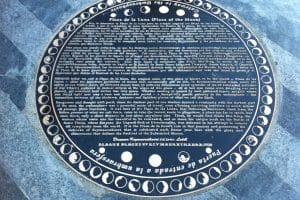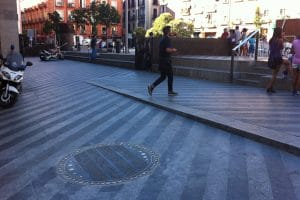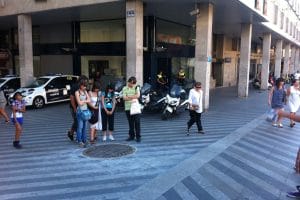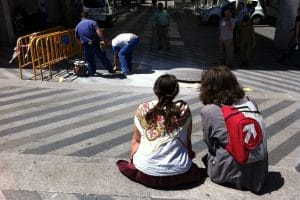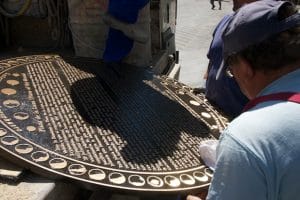Overview
This is the first time we have been able to honor a gateway to the Umbrasphaere—the connection between all the shadows and darkness on the planet. The darkest part of one shadow is always related to the darkest part of the next.
It also is a wonderful reminder of the way Nobunaga-Ventreven himself was such a connector of disparate parts of Kcymaerxthaere, his commitment to the richness of the world was, in some ways, unparalleled.
Access
Address: Plaza Santa Maria Soledad Torres Acosta, right in front of the police station, not far from the Gran Via, Madrid, Spain
Public Dedication
We had an amazing lunar landing party for the dedication.
This was Kcymaerxthaere installation #079 and the fourth in linear Spain.
Text of the Marker
The part of the story installed here:
Plaza of the Moon
Though today we call it Plaza de la Luna, the original name of this place is known to be the plural—Plaza de las Lunas—after the luminous perimeter of moons that occasionally gilt its rim. In Kcymaerxthaereal times, every 257 orbits of our visible moon, 29 different moons from 29 different dimensions (each symbolic of the 29 subtracted infinities of any xthaere) gathered in mutual eclipse at the edges of this plaza—all at full size (some even dwarfing our own planet), yet somehow held within this very space. Whether causing or caused by such gathered forces, roughly where you stand right now was a rare and invaluable portal—a deceptively gentle gateway to the umbrasphaere—the connection between all the shadows, darkness and lightless places of the what we call the Earth.
Dangerous and fraught with peril, since the darkest part of one shadow formed a continuity with the darkest part of the next, the umbrasphaere was a powerful route of travel, even allowing surviving travelers to avoid almost all ywrengs (time frontiers). It was here at the Plaza de las Lunas, that Nobunaga-Ventreven, fresh from the lichen gwomes of what we call Soria, came to take the fastest route to pSegolene, a place too far to reach, but once there, only a short distance to just about anywhere else. There, he would find Eliala Mei-Ning, the woman whose voice was too beautiful to be concealed, and so leave his unique mark on the Battle of Some Times, where Kmpass, the Urgend God of Directionality, was defeated in his attempt to remove all complexity from the world. It is the Plaza de la Luna’s role in that journey and preserving the richness of Kcymaerxthaere that is celebrated each linear year here with the glory and chiaroscuro that defines the Festival of the Subtracted Moons.
And in Spanish . . .
Plaza de la Luna
Hoy la llamamos la Plaza de la Luna pero su nombre original era Plaza de las Lunas, debido a que el resplandor de éstas demarcaban los límites de la plaza. En los tiempos de Kcymaerxthaereal, cada 257 órbitas de nuestra luna visible, convergían en este lugar, eclipsándose, las 29 lunas invisibles de las 29 dimensiones alternativas (cada una simbolizando los 29 infinitos negativos de cualquier xthaere), todas ellas en su plenitud (algunas eran más grandes que nuestro planeta), reunidas en este espacio. Esta conjunción de fuerzas puede ser la causa o la consecuencia de que esta plaza sea un portal insólito de incalculable valor, una puerta aparentemente pacífica hacia la umbraesfera, la conexión entre todas las sombras, la oscuridad y las penumbras de este planeta que llamamos Tierra.
Esta plaza era antaño peligrosa, ya que las distintas series dimensionales de sombras encadenaban sus zonas más oscuras, formando una ruta de viaje poderosa en la umbraesfera, que era transitada por los viajeros más audaces para evitar las ywrengs (fronteras del tiempo). Fue aquí, en la Plaza de las Lunas, donde Nobunaga-Ventreven, recién llegado de los gwomes de liquen, en el lugar que denominamos Soria, siguió la ruta más veloz a pSegolene, un sitio tan inaccesible como remoto, pero que, una vez que se llega, el viajero se encuentra paradójicamente cerca de cualquier otro punto del universo. Allí, tuvo lugar el encuentro con Eliala Mei-Ning, la mujer de la voz inconcebiblemente bella, dejando su huella en la Batalla de Sorne Times (Algunos Tiempos), donde Kmpass, el Urgende Dios de la Direccionalidad, fue derrotado cuando intentó destruir toda la complejidad del mundo. Es función y deber de la Plaza de la Luna preservar la riqueza de Kcymaerxthaere, por ello celebramos aquí cada año lineal la gloria y el claroscuro que define al Festival de las Lunas Restadas.

Gallery
Related Stories
Mlates gi Dunhuira
- Angel Alley and Surrounds
- The Gathering at the Llareggub
- The Unsoiling of Rockall
- The Lovers Touch
- Eine gefährliche Uberfahrt (A Dangerous Crossing)
- Poemas y Mapas de [Stoan Orange Glef]
- La Plaza de la Luna
- Place of Refuge
- Savior of a Friend
- The Way to the Moon (Paglalagay ng Mensahe sa Buwan)
- Lockstep (Sabay na paghakbang)
- Cave without Walls (无壁之穴)
- The Next Step (次の道程)
Nobunaga-Ventreven
- A Swath Like Stars
- A Swath of Stars
- The Lovers Touch
- Eine gefährliche Uberfahrt (A Dangerous Crossing)
- Poemas y Mapas de [Stoan Orange Glef]
- La Plaza de la Luna
- Lost in Scale (Tersesat dalam Skala)
- Place of Refuge
- Before the March
- Savior of a Friend
- Lockstep (Sabay na paghakbang)
- Cave without Walls (无壁之穴)
- The Next Step (次の道程)
Eliala Mei-Ning
- A Swath of Stars
- El Niño del Mar (The Boy from the Sea)
- Simultaneous Geographies
- Կրկներգի Բյուրեղներ (Crystals of Refrain)
- City of Justice (Teisingumo miestas)
- Willaugh Krk
- Eliala's 89th Place of Refuge (Tempat Persembunyian Eliala yang ke-89)
- Víddaflakk (Interdimensional Hopscotch) Main Jingkat Antar Dimensi
- 144
- A 17,711th Place of Refuge
- Eliala's 4181st Start
- Crystals of Refrain Entrance Marker
- La Plaza de la Luna
- Place of Refuge
- Lost in Scale (Tersesat dalam Skala)
- The Lichen Messiah
- El hilo de la memoria (Threads of Memory)
